2017 MERCEDES-BENZ E-CLASS ESTATE ESP
[x] Cancel search: ESPPage 41 of 585
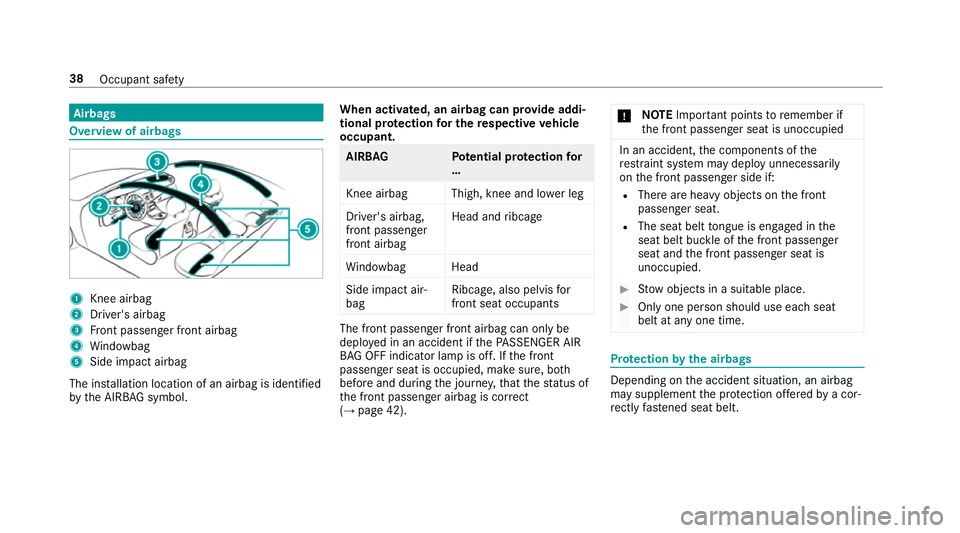
Airbags
Overvie
wofairbags 1
Knee airbag
2 Driver' sairbag
3 Front passenger front airbag
4 Windowbag
5 Sideimpact airbag
The ins tallation location of an airbag is identified
by theA IRB AG symbol. When activated, an airbag can pr
ovide addi‐
tiona lprotection fort he respectiv evehicle
occupant. AIRB
AG Potentia lprotection for
…
Knee airbag Thigh ,knee and lo werleg
Driver's airbag,
front passenger
front airbag Head and
ribcage
Wi ndowbag Head
Sid eimpact air‐
bag Ribca
ge,a lso pelvis for
front sea toccupants The front passenger front airbag can onl
ybe
depl oyed in an acciden tifthePASSENGER AIR
BA GO FFindicator lam pisoff.Ift he front
passenger seat is occupied, mak esure, bo th
befor eand during thej ourne y,that thes tatus of
th ef ront passenger airbag is cor rect
(→ page 42). *
NO
TEImpo rtant points toremember if
th ef ront passenger seat is unoccupied In an accident,
thec omponents of the
re stra int sy stem ma ydeplo yunnecessarily
on thef ront passenger side if:
R Ther eareheavy objects on thef ront
passenger seat.
R The seat belt tongu eise ngaged in the
seat belt buckle of thef ront passenger
seat and thef ront passenger seat is
unoccupied. #
Stow object sinas uitable place. #
Onlyone person should use eac hseat
belt at an yone time. Pr
otection bythea irbags Depending on
thea cciden tsituation ,anairbag
ma ysupplement thep rotection of fere dbyac or‐
re ctly fastened seat belt. 38
Occupant saf ety
Page 43 of 585
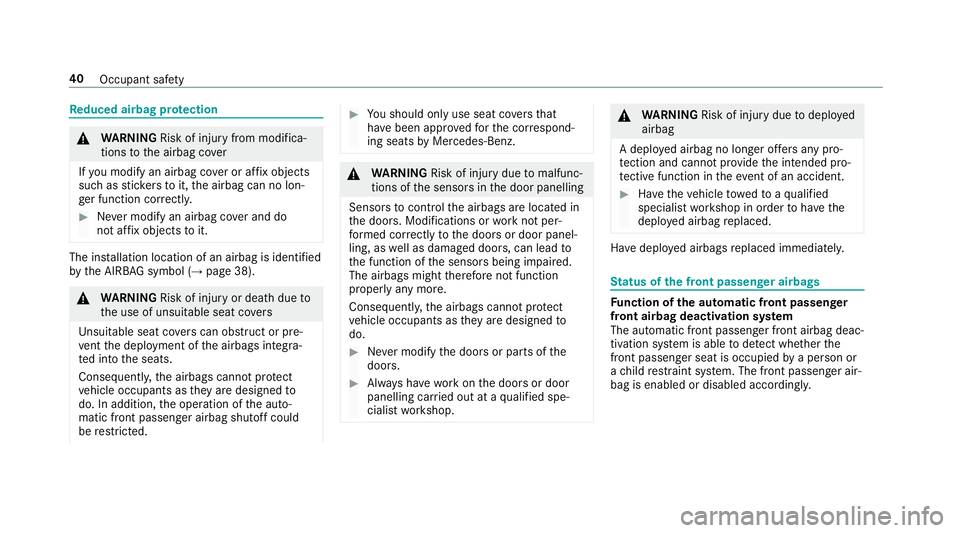
Re
duce dairbag pr otection &
WARNING Risk of inju ryfrom modi fica‐
tions tothea irbag co ver
If yo um odify an airbag co verora ffix objects
suc hass tickers to it,thea irbag can no lon‐
ge rfunction cor rectl y. #
Neverm odify an airbag co vera nd do
no ta ffix objectstoi t.The ins
tallation location of an airbag is identified
by theA IRB AG symbol (→ page38). &
WARNING Risk of inju ryor deat hdueto
th eu se of unsuitable seat co vers
Uns uitable seat co vers can obstruct or pre‐
ve nt thed eployment of thea irbags integra‐
te di ntot he seats.
Consequentl y,thea irbags cann otprotect
ve hicle occupants as they ared esigned to
do. In addition, theo peration of thea uto‐
matic front passenger airbag shutof fcould
be restricted. #
Yous hould on lyuse seat co vers that
ha ve been appr oved fort he cor respond‐
ing seats byMercedes-Benz. &
WARNING Risk of inju rydue tomalfunc‐
tions of thes ensor sinthe door panelling
Sensor stocontrol thea irbags ar elocated in
th ed oors. Modification sorworkn otper‐
fo rm ed cor rectl ytot he door sordoor panel‐
ling, as well as damaged doors, can lead to
th ef unction of thes ensor sbeing impaired.
The airbags might therefor enotfunction
proper lyan ym ore.
Consequent ly,t he airbags canno tprotect
ve hicle occupants as they ared esigned to
do. #
Neverm odify thed oor sorp arts of the
doors. #
Alw aysh ave workon thed oor sord oor
panelling car ried out at aqualified spe‐
cialis tworks hop. &
WARNING Risk of inju rydue todeplo yed
airbag
Ad eplo yeda irbag no longer of fers anyp ro‐
te ction and canno tprovide thei ntended pro‐
te ctiv efunction in thee vent of an accident. #
Have thev ehicle towe dtoaq ualified
specialis tworks hop in order tohave the
deplo yeda irbag replaced. Ha
ve deplo yeda irbags replaced immediately. St
atus of thef ront passenger airbags Fu
nction of thea utomatic front passenger
front airbag deactivation sy stem
The automatic front passen gerfront airbag deac‐
tivation sy stem is able todetect whe ther the
front passenger sea tisoccupied byap erson or
ac hild restra int sy stem. The front passenger air‐
bag is enabled or disabled accordingly. 40
Occupant saf ety
Page 45 of 585
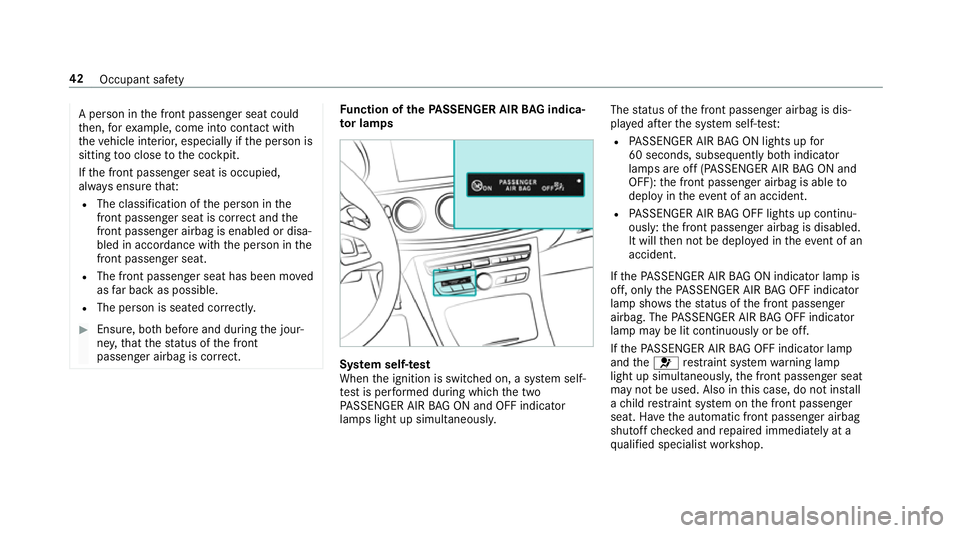
Ap
erso nint he front passenger seat could
th en, fore xamp le, com eintoc ontact wi th
th ev ehicle interior ,especially if thep erson is
sitting tooc lose tothec ockpit.
If th ef ront passenger seat is occupied,
alw ayse nsur ethat:
R The classification of thep erson in the
front passenger sea tiscorrect and the
front passenger airbag is enabled or disa‐
ble dina ccordance wit hthe person in the
front passenger seat.
R The front passenger sea thas been mo ved
as farb ackasp ossible.
R The person is seated cor rectl y. #
Ensu re,b othb efor eand during thej our‐
ne y,that thes tatus of thef ront
passenger airbag is cor rect. Fu
nction of theP ASSE NGER AIR BAGi ndica‐
to rlamps Sy
stem self- test
When thei gnition is switched on, asystems elf-
te st is per form ed during whic hthe two
PA SSENGER AIR BAGONa nd OFFindicator
lamps light up simultaneousl y.The
status of thef ront passenger airbag is dis‐
pla yeda fter thes ystem self-tes t:
R PASSENGER AIR BAGONl ightsupf or
60 seconds, subsequently bo thindicator
lamps ar eoff(PASSENGER AI RBAG ON and
OFF): thef ront passenger airbag is able to
deplo yintheeve nt of an accident.
R PASSENGER AIR BAGO FFlight supc ontinu‐
ously: thef ront passenger airbag is disabled.
It will then no tbed eployedint heeve nt of an
accident.
If th eP ASSENGER AIR BAGONi ndicator lam pis
off, on lytheP ASSENGER AIR BAGO FFindicator
lam pshows th estatus of thef ront passenger
airbag. The PASSENGER AIR BAGO FFindicator
lam pm aybe lit continuousl yorbeoff.
If th eP ASSENGER AIR BAGO FFindicator lamp
and the6 restra int sy stem warning lamp
light up simultaneousl y,thef ront passenger seat
ma ynotbe used. Also in this case, do no tins tall
ac hild restra int sy stem on thef ront passenger
seat. Ha vethea utomatic front passenger airbag
shutof fchec keda nd repaired immediately at a
qu alified specialis tworks hop. 42
Occupant saf ety
Page 47 of 585
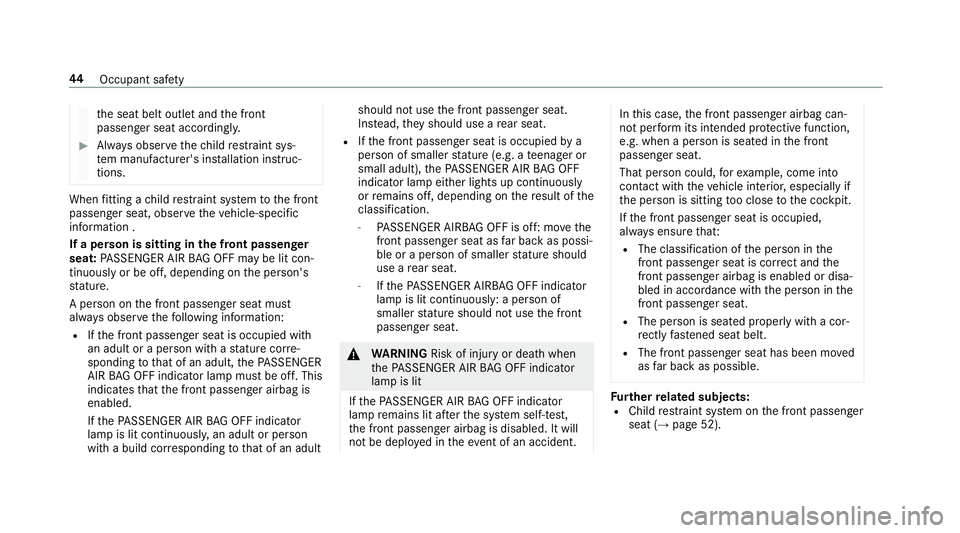
th
es eat belt outle tand thef ront
passenger seat accordingly. #
Alw ayso bser vethec hild restra int sys‐
te mm anufacturer's ins tallation instruc‐
tions. When
fitting achild restra int sy stem tothef ront
passenger seat, obser vethev ehicle-specific
information .
If ap erson is sitting in thef ront passenger
seat: PASSENGER AIR BAGO FFma ybel it con‐
tinuousl yorbeo ff,d ependin gonthe person's
st ature.
Ap erson on thef ront passenger seat must
alw ayso bser vethef ollowing information:
R Ifth ef ront passenger seat is occupied with
an adult or aperson wit hastatur ec orre‐
sponding tothat of an adult ,the PASSENGER
AIR BAGO FFindicator lam pmustbeo ff.T his
indicates that thef ront passenger airbag is
enabled.
If th eP ASSENGER AIR BAGO FFindicator
lam pisl it continuousl y,an adult or person
wit hab uild cor responding tothat of an adult shoul
dnotuse thef ront passenger seat.
Ins tead, they should use arear seat.
R Ifth ef ront passenger seat is occupied by a
person of smaller statur e(e.g. ateenager or
small adult), theP ASSENGER AIR BAGO FF
indicator lam peither light supcontinuously
or remains off, depending on ther esult of the
classi fication.
- PASSENGER AIRB AGOFF is off: mo vethe
front passenger sea tasfar ba ckas possi‐
ble or aperson of smaller statur eshould
use arear seat.
- Ifth eP ASSENGER AIRB AGOFF indicator
lam pisl it continuously: aperson of
smaller statur eshoul dnotuse thef ront
passenger seat. &
WARNING Risk of inju ryor deat hwhen
th eP ASSENGER AIR BAGO FFindicator
lam pisl it
If th eP ASSENGER AIR BAGO FFindicator
lam premain slit af tert he sy stem self-test,
th ef ront passenger airbag is disabled. It will
no tbed eployedint heevent of an accident. In
this case, thef ront passenger airbag can‐
no tp erform its intended pr otectiv efunction,
e.g. when aperson is seated in thef ront
passenger seat.
That person could, fore xamp le, com einto
con tact wi th thevehicle interior ,especially if
th ep erson is sitting tooc lose tothec ockpit.
If th ef ront passenger seat is occupied,
alw ayse nsur ethat:
R The classification of thep erson in the
front passenger sea tiscorrect and the
front passenger airbag is enabled or disa‐
ble dina ccordance wit hthe person in the
front passenger seat.
R The person is sea tedp roperly wit hacor‐
re ctl yfastened seat belt.
R The front passenger seat has been mo ved
as farb ackasp ossible. Fu
rther related subjects:
R Child restra int sy stem on thef ront passenger
seat (→ page52). 44
Occupant saf ety
Page 58 of 585

Label
forc hild restra int sy stems in accord‐
ance wit hECE R129
ISOFIX or i-Siz echild restra int sy stems of thef ol‐
lowing “Universal“ categor ycan be used, in
accordanc ewitht he tables on suitability of seats
fo rt he atta chment of child restra int sy stems, on
seats mar kedU,U F,IUF or i-U. Semi-universal
child restra int sy stems ar eindi‐
cated bythet ext" se mi-uni versal" on the
appr oval label. The ycan on ly beused if thev ehi‐
cle and thes eat ar eliste dint hechild restra int
sy stem manufacturer's vehicle model list.
Note sont he suitability of seats fora ttach‐
in gb elt-secured child restra int sy stems
Obser vethef ollowing information:
R When using ababyc ar seat of thec ate‐
gor y0/0+ and arear ward-facing child
re stra int sy stem on arear seat: adjustthe
driver's and front passenger seat suc hthat
th es eat does no ttouc hthe child restra int
sy stem.
R When using aforwa rd-facin gchild
re stra int sy stem of categor yI:remo vethe
head restra int from ther espectiv eseat, if
possible.Ina ddition,thes eat backres tofthe
ch ild restra int sy stem must, as farasp ossi‐
ble, lie flat agains tthe backres tofthevehicle
seat.
R When your emo vethec hild restra int sy stem,
fi tt he head restra int immediatel yand adjust
all theh ead restra int sa gain cor rectl y. R
Forc ertain child restra int sy stems in weight
categories II or III ,ther em ight be restrictions
in them aximum size setting, e.g. due topos‐
sible con tact wi th theroof.
R Mak esuret hat thec hild's feet do no ttouch
th ef ront seat. If necessar y,mo vethef ront
seat forw ards lightl y.
R The child restra int sy stem mus tnottouc ht he
ro of or be put under stra in by theh ead
re stra ints. Adjus tthe head restra int sa ccord‐
ingly.
R Obser vethem anufacturer's ins tallation
instructions fort he child restra int sy stem.
Legend fort he table:
X Notsuita blef or children in this we ight
categor y.
U Suitable forc hild restra int sy stems of
th e" Un iversal" categor yinthisweight
categor y. Occupant saf
ety55
Page 60 of 585
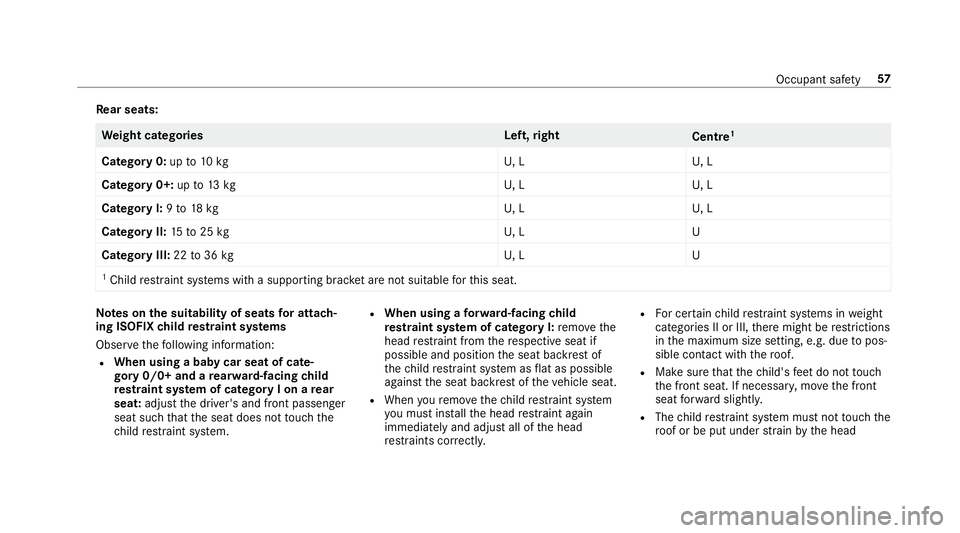
Re
ar seats: We
ight categories Left,right
Centre1
Categor y0:upto10 kg U,LU ,L
Categor y0+:up to13 kg U,LU ,L
Categor yI:9to18k gU ,LU, L
Categor yII:15 to25 kg U,LU
Categor yIII: 22 to36 kg U,LU
1 Child restra int sy stems wit hasupporting brac keta re nots uita blef or this seat. Note
sont he suitability of seats fora ttach‐
in gI SOFI Xchild restra int sy stems
Obser vethef ollowing information:
R When using ababyc ar seat of cate‐
gor y0/0+ and arear ward-facing child
re stra int sy stem of categor yIonarear
seat: adjustthe driver's and front passenger
seat suc hthat thes eat does no ttouc hthe
ch ild restra int sy stem. R
When using aforwa rd-facin gchild
re stra int sy stem of categor yI:removethe
head restra int from ther espectiv eseat if
possible and position thes eat backres tof
th ec hild restra int sy stem as flat as possible
agains tthe seat backres tofthevehicle seat.
R When your emo vethec hild restra int sy stem
yo um ustins tallth eh ead restra int again
immediatel yand adjus tall of theh ead
re stra int sc orrectl y. R
Forc ertain child restra int sy stems in weight
categories II or III ,ther em ight be restrictions
in them aximum size setting, e.g. due topos‐
sible con tact wi th theroof.
R Mak esuret hat thec hild's feet do no ttouch
th ef ront seat. If necessar y,mo vethef ront
seat forw ards lightl y.
R The child restra int sy stem mus tnot to ucht he
ro of or be put under stra in by theh ead Occupant saf
ety57
Page 62 of 585
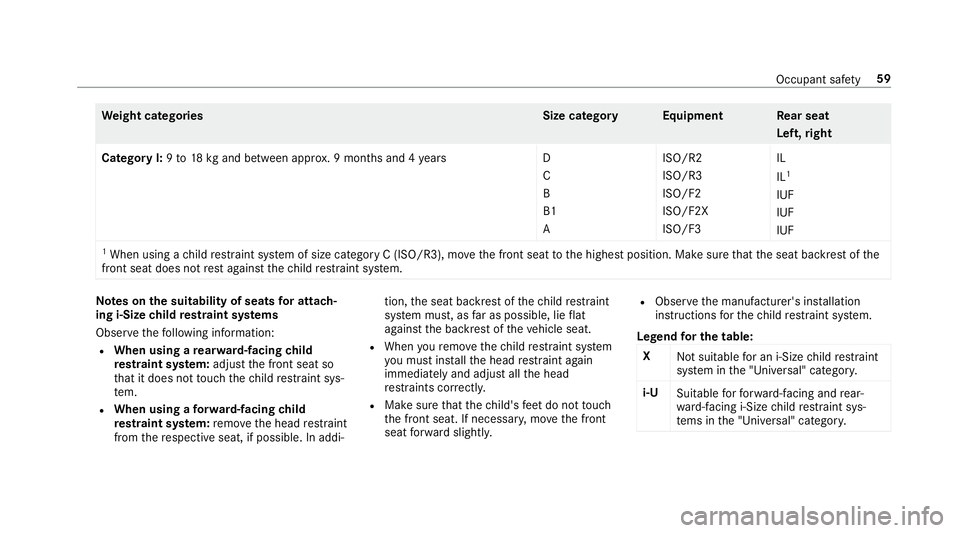
We
ight categories Size categoryEquipment Rear seat
Left ,right
Categor yI:9to18kga nd between appr ox.9m onths and 4year sD
C
B
B1
A ISO/R2
ISO/R3
ISO/F2
ISO/F2X
ISO/F3IL
IL
1
IUF
IUF
IUF
1 Whe nusing achild restra int sy stem of size categor yC(ISO/R3), mo vethef ront seat totheh ighes tposition .Makes uret hat thes eat backres tofthe
front seat does no tres ta gains tthe child restra int sy stem. Note
sont he suitability of seats fora ttach‐
in gi ‑Size child restra int sy stems
Obser vethef ollowing information:
R When using arear ward-facing child
re stra int sy stem: adjus tthe front seat so
th at it does no ttouc hthe child restra int sys‐
te m.
R When using aforwa rd-facin gchild
re stra int sy stem: remo vetheh ead restra int
from ther espectiv eseat, if possible.Ina ddi‐tion,
thes eat backres tofthechild restra int
sy stem must, as farasp ossible, lie flat
agains tthe backres tofthevehicle seat.
R When your emo vethec hild restra int sy stem
yo um ustins tallth eh ead restra int again
immediatel yand adjus tallth eh ead
re stra int sc orrectl y.
R Mak esuret hat thec hild's feet do no ttouch
th ef ront seat. If necessar y,mo vethef ront
seat forw ards lightl y. R
Obser vethem anufacturer's ins tallation
instructions fort he child restra int sy stem.
Legend fort he table:
X Notsuita blef or an i-Siz echild restra int
sy stem in the" Universal" categor y.
i‑U Suitable forf or wa rd-facin gand rear‐
wa rd-facing i-Size child restra int sys‐
te ms in the" Universal" categor y. Occupant saf
ety59
Page 68 of 585
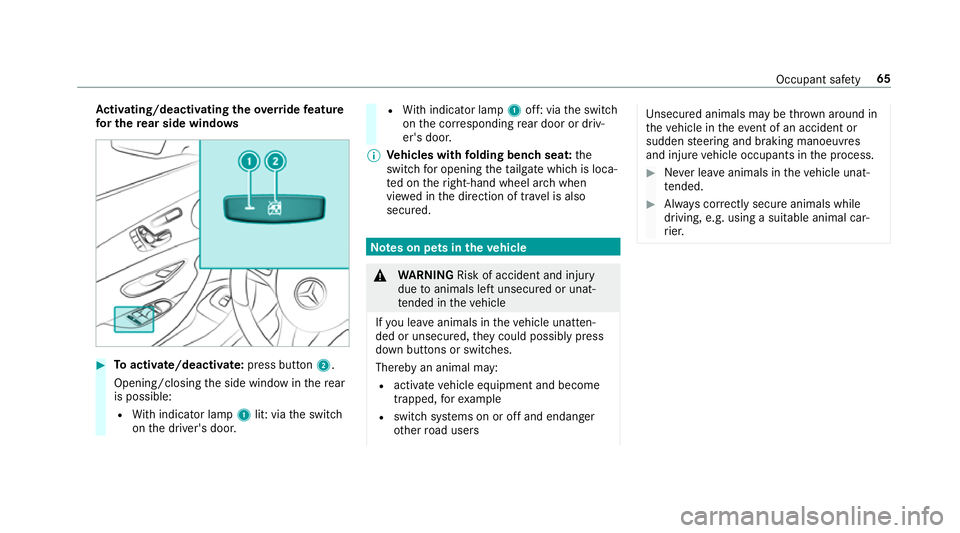
Ac
tivating/deactivatin gthe ove rride feature
fo rt he rear side windo ws #
Toactivate/deacti vate: press button 2.
Opening/closing thes ide windo wintherear
is possible:
R With indicator lamp 1lit:v ia thes witch
on thed rive r's door. R
With indicator lamp 1off: via thes witch
on thec orresponding rear door or driv‐
er' sd oor.
% Vehicles with folding benc hseat: the
switc hfor opening thet ailgat ewhichisl oca‐
te dont heright-hand wheel ar chwhen
vie we dint he direction of tr avel is also
secured. Note
sonp etsint hevehicle &
WARNING Risk of accident and inju ry
due toanimals lef tunsecured or unat‐
te nde dint hevehicle
If yo ul eave animals in thev ehicle unatten‐
ded or unsecured, they could possib lypress
down buttons or switches.
Thereb yananimal may:
R activat evehicle equipment and become
trapped, fore xamp le
R swit chsystems on or of fand endanger
ot her road users Uns
ecured animals ma ybethrow na roun din
th ev ehicle in thee vent of an accident or
sudden steering and braking manoeuvres
and injur evehicle occupants in thep rocess. #
Neverlea ve animals in thev ehicle unat‐
te nded. #
Alw aysc orrectly secu reanimals while
driving, e.g .usin gas uitable animal car‐
ri er. Occupant saf
ety65